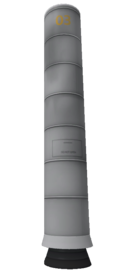BACC "Thumper" Solid Fuel Booster
| BACC "Thumper" Solid Fuel Booster | ||
| Solid rocket booster by Rockomax Conglomerate | ||
| Radial size | Small, Radial mounted | |
| Cost | (total) | 850.00 |
| (dry) | 358.00 | |
| Mass | (total) | 7.650 t |
| (dry) | 1.500 t | |
| Drag | 0.2-0.3 | |
| Max. Temp. | 2200 K | |
| Impact Tolerance | 7 m/s | |
| Research | | |
| Unlock cost | 2 800 | |
| Since version | 0.16 | |
| Part configuration | solidBoosterBACC.cfg | |
| Maximum thrust | (1 atm) | 250.00 kN |
| (vacuum) | 300.00 kN | |
| Isp | (1 atm) | 175 s |
| (vacuum) | 210 s | |
| Fuel consumption | 19.42 | |
| Thrust vectoring | No | |
| Burn time | (1 atm) | 35.2 s |
| (vacuum) | 42.2 s | |
| Testing Environments | ||
| On the surface | No | |
| In the ocean | No | |
| On the launchpad | Yes | |
| In the atmosphere | Yes | |
| Sub-orbital | Yes | |
| In an orbit | Yes | |
| On an escape | No | |
| Docked | No | |
| Test by staging | Yes | |
| Manually testable | Yes | |
| Solid fuel | 820 | |
The Rockomax BACC Solid Fuel Booster is a large solid rocket booster.
Usage
BACCs are one-shot rocket boosters often used to help get the massive bulk of a large multi-stage rocket off the ground. They burn at a constant thrust until they run out of fuel and then cease to work. It should be noted that more boosters doesn't reduce the need for liquid fuel, as one must also take into account thrust-to-weight ratios. Thrust can be regulated with tweakables. The minimum thrust required for booster to lift its own weight off Kerbin's surface is 24 %, or about 76 kN.
BACC Solid Fuel Boosters are prone to overheating, especially when large numbers are clustered together. The best way to prevent this is by using custom staging to stagger the firing and attaching additional parts that are not SRBs, typically parts such as struts, control surfaces or winglets, to act as heat sinks.
In version 0.25, the BACC has an on-pad specific impulse (or Isp) of 230, slightly better than that of the RT-10 Solid Fuel Booster and comparable to the least efficient liquid fuel engines. Its thrust-to-mass ratio is high enough to make it a popular choice on first stages.
Product description
| “ | Filled with a new, even more volatile fuel, the BACC offers semi-reliable performance at a good price. | ” |
Changes
- Thrust increased from 300 to 315. Dry mass reduced from 1.75 to 1.5.
- Thrust decreased from 550 to 300.
- Other small performance tweaks.
- Thrust increased from 400 to 550.
- Initial Release
